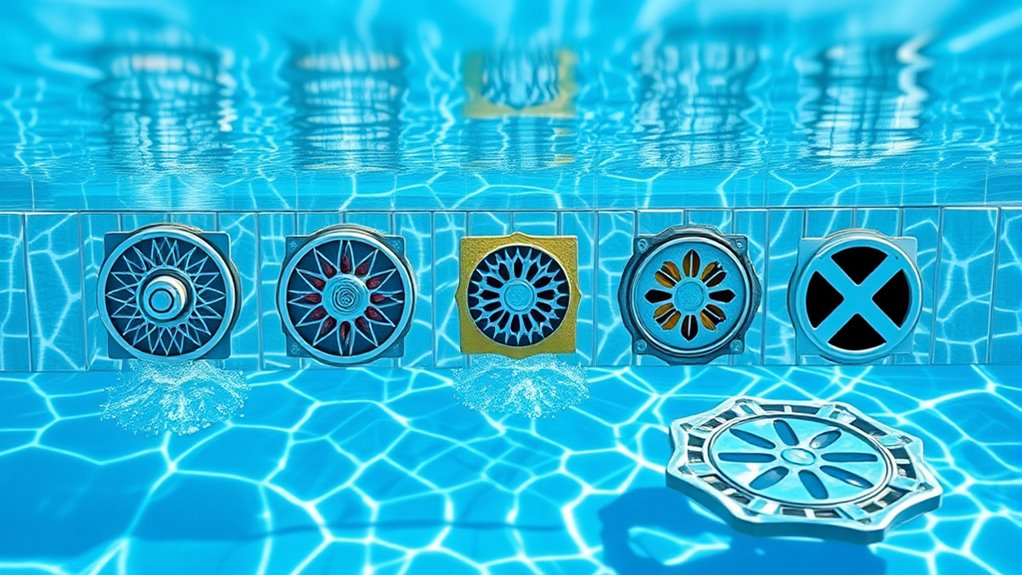3D printed pool components are revolutionizing customization by giving you the ability to design intricate fittings, unique skimmer shapes, and personalized features tailored to your preferences. These parts are eco-friendly, cost-effective, and produced quickly, reducing project timelines and waste. With high precision and quality, you can create durable, complex designs that traditional methods can’t match. Keep exploring to discover how this innovative technology can transform your pool project entirely.
Key Takeaways
- Enables highly personalized pool designs with intricate fittings and unique features tailored to individual preferences.
- Allows rapid prototyping and iterative modifications for customized components, reducing development time.
- Supports complex geometries and precise specifications unattainable with traditional manufacturing methods.
- Facilitates eco-friendly pool construction using sustainable, biodegradable materials.
- Lowers costs and lead times, making bespoke pool components more accessible and efficient to produce.

3D printing is transforming the way pool components are designed and manufactured, offering innovative solutions that were once impossible or too costly with traditional methods. One of the biggest advantages you’ll find is the ability to use sustainable materials, making your pool projects more eco-friendly without sacrificing quality. These materials reduce waste during production and often come from renewable sources, aligning with environmentally conscious choices. By integrating sustainable materials into 3D printing processes, you can considerably lower the environmental impact of manufacturing pool parts, all while maintaining durability and performance.
Cost-effective manufacturing is another key benefit that directly impacts your project’s budget. Traditional pool component fabrication often involves expensive molds, long lead times, and large minimum order quantities. With 3D printing, you eliminate many of these costs because you can produce complex parts on-demand and in smaller quantities. This flexibility allows you to prototype new designs quickly, test them, and make adjustments without breaking the bank. Once finalized, 3D printing can produce high-quality components rapidly and at a fraction of the cost of conventional methods, helping you stay within budget without compromising on customization or function.
Moreover, 3D printing enables you to create highly customized pool components tailored precisely to your specifications. Whether it’s intricate fittings, unique skimmer designs, or personalized pool features, the ability to rapidly iterate and produce bespoke parts means your pool can truly stand out. You’re not limited by standard sizes or designs anymore; instead, you can craft parts that fit perfectly within your space and aesthetic preferences. This level of customization was difficult and expensive to achieve with traditional manufacturing, but now it’s accessible and affordable.
The process also shortens lead times considerably. Instead of waiting weeks for parts to be manufactured through conventional means, you can go from design to finished component in a matter of days. This rapid turnaround accelerates project timelines, allowing you to implement innovative ideas faster and respond swiftly to any changes or custom requests. Plus, 3D printing reduces waste because it builds parts layer by layer, using only the material needed, which is particularly beneficial when working with sustainable materials. Additionally, advancements in high-resolution 3D printing technology ensure that the quality and precision of your pool components are maintained, further enhancing the final result.
Frequently Asked Questions
What Are the Cost Differences Between 3D Printed and Traditional Pool Components?
You’ll find that 3D printed pool components often cost less upfront, thanks to material flexibility and reduced labor. While traditional parts can be pricier due to complex manufacturing, 3D printing offers more affordable options for intricate designs. Over time, savings accumulate because of quicker production times and less waste. Overall, 3D printing tends to be more cost-effective, especially for custom or complex pool components.
How Durable Are 3D Printed Pool Parts Over Long-Term Use?
Your 3D printed pool parts are quite durable if made from high-quality materials. They resist corrosion better, thanks to their corrosion resistance, and are designed to handle material fatigue over time. While they may not match the longevity of traditional components in extreme conditions, proper maintenance and selecting the right material can guarantee they last many years, providing reliable performance for your pool.
Can 3D Printed Components Withstand Extreme Weather Conditions?
While 3D printed pool components have impressive potential, their material resilience and weather resistance can vary. You might find that high-quality materials, like certain thermoplastics, handle extreme weather reasonably well, but prolonged exposure to intense sun, cold, or moisture could challenge their durability. To guarantee longevity, selecting components made from specially engineered, weather-resistant materials is key, helping your pool stand up to Mother Nature’s toughest surprises.
Are 3D Printed Pool Components Environmentally Friendly?
You might wonder if 3D printed pool components are environmentally friendly. While they can reduce waste and enable customization, recyclability concerns arise because not all materials are recyclable. Additionally, the energy consumption during printing can be high, impacting sustainability. However, using eco-friendly materials and energy-efficient printers can mitigate these issues, making 3D printed pool components a more sustainable choice for environmentally conscious pool owners.
How Long Does It Take to Produce Custom 3D Printed Pool Parts?
You can typically produce custom 3D printed pool parts in just a few hours to a few days, depending on complexity. A recent study shows that 3D printing reduces production timelines by up to 50% compared to traditional methods. Your customization options are virtually limitless, allowing you to design unique parts tailored perfectly to your pool’s needs. This quick turnaround means you get personalized components faster and more efficiently.
Conclusion
As you explore 3D printed pool components, you’ll discover how customization becomes faster and more affordable. Did you know that 78% of pool owners prefer tailored designs, making personalization a top priority? Embracing this technology means you can create unique, durable parts that fit perfectly and reduce waste. The future of pool design is here, and with 3D printing, you’re in control of a more innovative, efficient, and personalized swimming experience.









